Rebecca Lerner's Blog, page 6
July 23, 2013
The Many Wonders of St. John’s Wort
 You can be sure it’s summertime when you see these bright yellow St. John’s Wort flowers growing like weeds along the sidewalk, in sun-drenched meadows, and in gardens all around. The leaves and flowers of this plant are well-known for their use as a popular antidepressant when prepared as a tea or tincture and taken internally, but I get most excited about Saint John’s Wort for its topical uses.
You can be sure it’s summertime when you see these bright yellow St. John’s Wort flowers growing like weeds along the sidewalk, in sun-drenched meadows, and in gardens all around. The leaves and flowers of this plant are well-known for their use as a popular antidepressant when prepared as a tea or tincture and taken internally, but I get most excited about Saint John’s Wort for its topical uses.
When infused into oil or made into a salve, St. John’s Wort, Hypericum perforatum, is an anti-inflammatory and wound-healing agent, is wonderful for burns, and may even work as a sunscreen. That’s why my favorite herbal lip balm recipe is to take a glass jar filled with dried Saint John’s Wort and soothing Calendula flowers, cover it entirely with sunflower oil, use heat to infuse the herbs into the oil (in the hot weather you can use the sun – though it is best to protect the jar from light – or you can use a stove on a very low setting), then strain and mix the oil with melted beeswax in a crockpot and add a few drops of an essential oil (especially peppermint and lavender together!) as a preservative and to scent the product. My friends who have benefitted from my surplus *love* this stuff — it’s amazing! — so if you’re looking for a unique homemade gift you can share, this makes a great one!
St. John’s Wort oil is also useful externally on neuralgia, sciatica, arthritic pain, neck cramps and muscle pain. The oil can be taken internally, as well, for healing stomach ulcers.
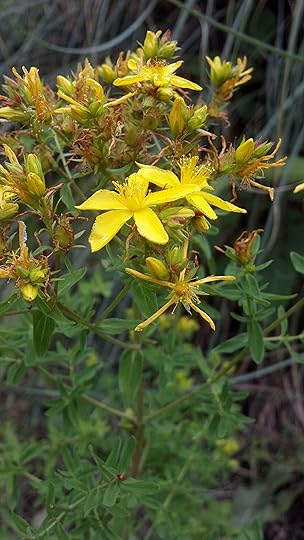 You can identify the flower by its bright yellow color, five petals, and many stamens in the middle. Then notice that the small leaves, if plucked and held up to the sky, will appear to have tiny pin holes in them, which is reflected in the second part of its Latin name: perforatum. Squeezing a leaf between your thumb and forefinger will also result in little purple dots staining your finger — this is the hypericin, a medicinal ingredient.
You can identify the flower by its bright yellow color, five petals, and many stamens in the middle. Then notice that the small leaves, if plucked and held up to the sky, will appear to have tiny pin holes in them, which is reflected in the second part of its Latin name: perforatum. Squeezing a leaf between your thumb and forefinger will also result in little purple dots staining your finger — this is the hypericin, a medicinal ingredient.
St. John’s Wort grows in almost every state in America, with the exception of Florida and Texas, so if you’re reading this, there’s a good chance you’ll come across it. Best of luck!
Sources: “The Way of Herbs” by Michael Tierra, “Medicinal Plants of the West” by Michael Moore, “Holistic Herbal” by David Hoffman.
***
Join me for an urban foraging webinar today at 3 pm Pacific / 6 pm Eastern! Click here for info and to register.
On Sunday, August 4, I’ll be leading a smoking ceremony and guided meditation to connect with passionflower and angelica in West Linn, OR, as part of a new moon circle for women. $30 if you sign up before July 25; $35 after. For more info, click here.
Learn more plants on the Search Plants page here.







July 22, 2013
In Case You Missed It – Anna’s Q&A
The following interview is reposted from Anna Mezger-Sieg Bradley’s plant blog Feral Botanicals. It’s my favorite Q&A so far about my book, Dandelion Hunter
Anna: What inspired you to write a book about foraging?
Me: I wanted to write an entertaining true story that would be inspiring and provocative, and that would make use of my skills as a journalist at the same time, and my experience over the past five years as a forager had plenty of good material. Because of my urban foraging blog, I was actually getting book offers from publishers before I even had any intention to write one. It happened that I was in an MFA program for creative nonfiction writing at the time, too, so it seemed that the Universe was conspiring to make this happen. I knew that there were foraging cookbooks out there, and plenty of field guides, and a memoir or two, and I wanted to do something different, something colorful and philosophical that could, hopefully, change ideas about our place in nature for the better.
Dandelion Hunter covers a wide range of information from ethical harvesting, exploding slugs, to the archaeological record. What do you want your readers to take away from your book?
I hope that Dandelion Hunter inspires readers to view plants as the key to a magical and fascinating multi-dimensional world with a tremendous history and an exciting future. I find that foraging has the power to catalyze a consciousness shift that inspires respect for plants, demonstrates nature’s utility and a way of enjoying that while being in balance with it, and even elevates nonhuman beings to the level of person. I hope it gives the world an even stronger reason to protect the wilderness and expand it, and to clean up our cities.
A large percentage of your audience may be experienced foragers themselves – will Dandelion Hunter cater to those people?
This book has something for everyone. Beginning foragers and herbalists will learn a ton from the botanical info woven through this book, and more experienced plant folks will enjoy the stories, the characters, the research, and the interesting perspectives on display. I asked the expert foragers Sam Thayer and Fergus Drennan to check it out, and they both loved it, as did herbalist Matthew Wood. Fergus actually suggested that it can be read as a feminist perspective on survivalism, which is a really cool idea.
Readers may be concerned about urban pollution. How do you address this?
Urban pollution is a legitimate concern, and one of the reasons I love teaching folks about urban foraging is because it shows us the abundance we could have access to if we took better care of our land. I think the more of us urban wildcrafters there are, the stronger an argument we can make for banning lawn chemicals and pesticides and remediating the soil. In the meantime, I’ve learned through looking at urban agriculture research that the reproductive parts of plants — the fruit and nuts — tend to be safest from contaminants, and that the biggest risk comes from touching the soil more so than from what plants absorb from it, at least in terms of heavy metals.
Do you advocate that everyone harvest wild food and medicine?
I think wild harvesting is a really special way to get in touch nature, and especially with the primal part of ourselves that feels a strong spiritual connection to Earth. I find it to be a tremendously healing experience, and I hope everyone gets to feel that. Here is where sustainability concerns inevitably pop up. Most of us, myself included, don’t have the time to forage our diets full time, and it would be a stress on our land if everyone attempted to do that all at once, but it would be great if we expanded the wilderness and brought more of it into our cities and towns so that more of us have access to wild crafting and wild harvesting our food, whether as a hobby or as sustenance.
Learn about Anna’s work in the field of wilderness survival on her blog here







July 21, 2013
Radio & Reviews: All the Latest Book News
* Seattle’s NPR radio station, KUOW, aired an interview with me about my book, Dandelion Hunter, on Wednesday. Listen to it online here.
* Portland’s NPR radio station, OPB, will air an interview I did with Julie Sabatier of “Destination DIY” later this summer as part of an hourlong episode called “Old School DIY,” and it’s available as a podcast online here if you want an early listen.
* ForeWord magazine, which has book reviews featuring “independent voices” in the alternative/indie market, had glowing things to say about Dandelion Hunter. Read it here.
* The Princeton Packet, a biweekly newspaper in New Jersey, recently published a nice feature profile about my work. Read it here.
* Anna of the awesome herbal blog Feral Botanicals just published a Q&A with me about Dandelion Hunter. She asked me why I wrote it and what message I wanted to get across. Read her excellent interview here.
* I have been invited to read on stage at Portland’s literary festival, Wordstock, this October.
* Trivia: I have gotten many compliments on the cover design. I love it, too! The credit goes to a designer who is employed by my publisher, Globe Pequot Press, though I did ask them to do something stencil-street-art, psuedo-Banksy, and with a silhouette of a dandelion blowing up the cover. I’m psyched that they listened to me on that because I think it looks fabulous!
* You can catch me reading from my book live online this Tuesday, July 23, at 3 pm Pacific or 6 pm Eastern during the three-hour Urban Foraging webinar I’ll be doing for Nightlight Astrology and Sky House Yoga. I’ll also be highlighting my favorite wild urban plants. To tune in, they request that you e-mail NightlightAstrology@gmail.com to register and make a small sliding scale donation of $15 to $25 via their website.
You can get Dandelion Hunter as a paperback or e-book on Amazon, from your local independent bookseller, or, if you want a signed copy, directly from me.







July 16, 2013
On Mistakes: Or, How to Screw Up and Die
 One of the local alternative weekly newspapers here, the Willamette Week, ran a story on poisonous wild berries this past week. At first I was psyched to see it, and then as I read it I was bummed to see many inaccuracies. For example, they mistakenly reported that bittersweet, Solanum dulcamara, is poisonous to sniff the scent of and also a potentially lethal hallucinogen. Bittersweet is not poisonous to sniff. It is poisonous to eat but is rarely lethal (fortunately), and it is not generally regarded as a hallucinogen, and has no ethnobotanical history of use that way, which one would generally expect if it had any potential in that regard. It could be considered a deliriant, technically, but that’s not the same thing and there are few if any reports of poisonings that discuss this as a symptom. When I asked the newspaper for their source, they sent me to a museum website in Nova Scotia. The website had mistakenly stuck information about Jimsonweed, Datura stramonium, in an article about Bittersweet. The museum writer, not paying any attention to Latin names for the plants, apparently got confused and must have assumed that they were the same thing (even though they don’t look alike). The newspaper, in turn, made the usually-safe assumption that a museum website was a reliable source and repeated their error.
One of the local alternative weekly newspapers here, the Willamette Week, ran a story on poisonous wild berries this past week. At first I was psyched to see it, and then as I read it I was bummed to see many inaccuracies. For example, they mistakenly reported that bittersweet, Solanum dulcamara, is poisonous to sniff the scent of and also a potentially lethal hallucinogen. Bittersweet is not poisonous to sniff. It is poisonous to eat but is rarely lethal (fortunately), and it is not generally regarded as a hallucinogen, and has no ethnobotanical history of use that way, which one would generally expect if it had any potential in that regard. It could be considered a deliriant, technically, but that’s not the same thing and there are few if any reports of poisonings that discuss this as a symptom. When I asked the newspaper for their source, they sent me to a museum website in Nova Scotia. The website had mistakenly stuck information about Jimsonweed, Datura stramonium, in an article about Bittersweet. The museum writer, not paying any attention to Latin names for the plants, apparently got confused and must have assumed that they were the same thing (even though they don’t look alike). The newspaper, in turn, made the usually-safe assumption that a museum website was a reliable source and repeated their error.
That wasn’t the end of it. The newspaper reporter also mistakenly wrote that uncooked elderberries are safe to eat but that at the same time they’ll poison you and become cyanide in your body if you eat too many. Obviously, that doesn’t make sense. They were confusing the caveat about the need to cook red elderberries with the edibility of other species, and were confusing the chemicals in the leaves with the chemicals in the berries. All parts of elderberry except for flowers and fruits contain compounds that become cyanide in the body. Uncooked red berries simply cause stomach upset; raw blue or black are fine. And they’re really tasty, too. When I told the editor about all these mistakes, he told me I was wasting his time and that it was all just semantics. Wow, Willamette Week. I used to respect you. (For accurate info on elderberry, click here). Edited to add: To their credit, they’ve agreed to run corrections. And the editor apologized to me.
Meanwhile, another forager blogger recently wrote about trying to eat a plant she referred to only by its common name of “Skunk Cabbage.” It’s a good thing she said it tasted bad because it wasn’t that plant at all but instead a highly poisonous plant that looks similar, Veratrum viride, also commonly called False Hellebore. “Skunk cabbage” is a common name that can refer to multiple species, but usually out West it means . When some astute readers pointed out her major mistake on Facebook, she explained that someone in her community had said it was edible so she trusted that, and avoided addressing it on her blog. After a lot of pressure, she eventually posted a blog entry mentioning that there had been a misunderstanding, but didn’t tell her readers the Latin names of the plants or explain how they could avoid doing the same thing. Wow, did this ever bug me! If you’re a source of information for people, you have responsibilities to them, and those responsibilities are supposed to trump your sore-ass ego.
Sure, being wrong can really be embarrassing sometimes, especially when you’re in a position of authority on a subject. Recently, for example, I believed a friend new to foraging who casually told me that a plant in her yard was belladonna, so I called it belladonna whenever I saw it around town, until someone else more knowledgeable pointed out to me that actually it was bindweed, Convulvus arvensis, a plant in the morning glory family, and not belladonna, Atropa belladonna. (Both are poisonous). I could’ve averted my mistake by fact-checking my friend’s initial comment and looking it up by Latin name. That would’ve lead me to images that clearly didn’t match. (This mistake was not on my website. If it had been, I would have corrected it).
Screw-ups like these are very common. It is extremely easy to make mistakes in the world of plants, because there are so many plants out there, and also so much bad information out there. In fact, it’s so easy that I almost don’t trust someone who hasn’t screwed up. And that’s one of the reasons why I am a big fan of the very responsible forager blogger Wild Food Girl, who should be commended. She is very reliable, but on the rare occasion that something turns out to be incorrect, she promptly runs corrections and takes full accountability.
The moral of this story is two-fold: 1) Always use the Latin name of the plants you’re interested in, not the common name. 2) Be discerning. Just because you read it on the Internet doesn’t mean it’s correct, and sometimes even published books are wrong. Which are reliable? I have a list of recommended field guides on my Resources page.
Also feel free to check out my ever-expanding Search Plants! page, which lists all the plants I’ve written about in my five years or so of blogging here. I’m perpetually updating it and it’s currently got 50+ entries. It may well double as I catch up with adding the back entries. Click the names, not the photos, to go to old posts.
And, hey – I definitely want to hear your thoughts on this one. Comments?







July 15, 2013
Salal: Looks & Tastes Like Blueberries
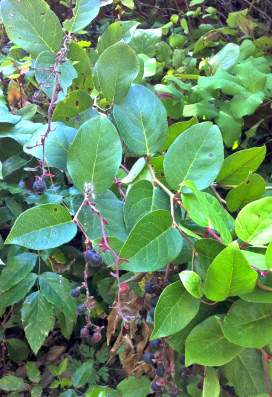 Today I was visiting Cathedral Park in the St. John’s neighborhood of North Portland when I spotted some salal berries planted, conveniently, right next to some equally ripe and edible Oregon grape berries. Lucky me, I ate them both and had a free wild snack.
Today I was visiting Cathedral Park in the St. John’s neighborhood of North Portland when I spotted some salal berries planted, conveniently, right next to some equally ripe and edible Oregon grape berries. Lucky me, I ate them both and had a free wild snack.
Salal, Gaultheria shallon, is a shrub (or a bush) native to the Pacific Northwest. It has alternate, leathery-textured oval leaves and big round blue berries. It grows at low to mid elevations and is especially common in the forest understory and in Portland-area landscaping.
The berries are really good, similar to blueberries in flavor and appearance. The stems attached to the berries are red, making for high contrast with the fruit. In some areas, especially those at higher elevations, salal is still only just flowering. If you see it in that phase of its life, you’ll notice the flowers are whitish or pale pinkish and shaped like upside down cups. (See photo below).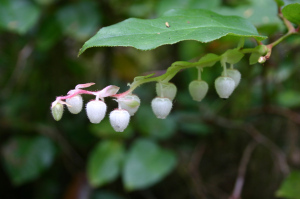 ***
***
Upcoming Classes:
1) Urban Foraging Webinar for Nightlight Astrology & Sky House Yoga – 6 pm to 9 pm EST/3 pm to 6 pm Pacific on Tuesday, July 23 on the Internet!
A three-hour interactive video class covering foraging basics & safety, some of my favorite useful wild plants of the city, time for Q&A, and a reading from Dandelion Hunter.
Fee: $15 to $25 suggested donation. Register by e-mailing NightlightAstrology@gmail.com
2) Angelica & Passionflower New Moon Ceremony for Dancing OM’s Wild WOMBan’s Moon Circle – 6:30 pm to 8:30 pm on Sunday, Aug. 4 in West Linn, OR
A special guided meditation and smoking ceremony to connect with these two botanical allies and honor the spirit of Water on a beautiful 4-acre property. Passionflower is gentle and expansive and helps us move into a receptive yin space, whereas Angelica holds the energies of steady and strong.
Fee: $30 when you sign up by July 25, $35 after. Register here.
3) Wild Foraging Adventure – Sunday, Aug. 18 in Willamina, OR – SOLD OUT
***
Want to know what wild things are growing in your yard? Or want a special class for your organization? I’m available for hire by private groups and individuals. For more info, check out my Classes page or send an email to RebeccaELerner[at]gmail.com







June 23, 2013
Sunshine Incarnated: Calendula!
In Mexico, Calendula officinalis, also called Marigold, is associated with the Day of the Dead holiday, and Mexicans traditionally strew it on grave sites. According to folklore, that’s because it’s the plant that sprung up from the blood of Mexicans who once died at the hands of the invading Spaniards.
Originally, Calendula is native to the Mediterranean, but once you know this flower’s amazing array of medicinal uses, it’ll be easy to see why the Europeans embraced it and introduced it. Today you can find it in direct sunlight throughout Europe and North America along roadsides and in gardens.
When applied externally in a poultice (paste made of crushed herb + water), or dried and then infused in an oil or salve, Calendula blossoms are excellent for healing burns and wounds. They can also stop bleeding because of its astringent action. If you make a tea of it and apply the cooled water to the skin, it can cure shingles. Internally, it is soothing and healing for ulcers and menstrual cramps. It is anti-inflammatory, anti-fungal, and antimicrobial, too.
Note: Calendula is also an emmenagogue (an herb that sends blood to the uterus) so it should not be taken internally during pregnancy.
And that’s not all — the bright orange, daisy-like flowers are edible and taste really good! Slightly spicy, even.
According to the book Herbal Magick by Paul Beyerl, Calendula is used for divination, particularly for those who have been stolen from. It is said to cleanse negative energy and aid sight as well, and its astrological association is the sign Leo (my sign!).
Discover more amazing plants on the Search Plants! page.
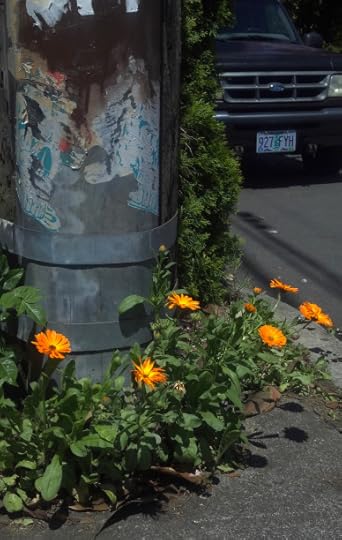
***
Want to learn to identify plants, make medicine with me, or experience plant spirit work in person? I offer private classes for groups and am happy to come to you. More info here.







June 18, 2013
Wanted: Women Who Love Weeds
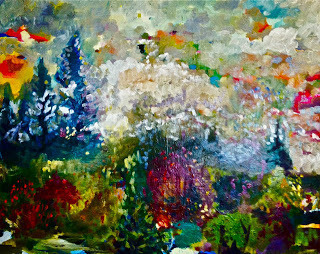
Painting by Jenn Finn
Portland artist Jennifer Finn is seeking “women who love weeds” and ”who have a deep relationship with the earth around their homes — and particularly women who have a specific plant that grows repeatedly in their yards” to participate in an art project that will involve being photographed, interviewed, and possibly painted, too.
She adds, “Side note: In order to participate you would have to be willing to let your weed grow in a small portion of your yard so that I can see it, photograph it, and research it.” Due to these logistics, Jenn’s seeking participants in the Portland area only.
“I can’t monetarily compensate anyone for participating, but I’m hoping that we will all learn a lot, that it will be fun, and that it will produce some astounding works of art. And I’m envisioning a Women and their Weeds potluck at some point over the summer,” she says.
For more info on Jennifer’s work, visit her website at http://www.jennfinn.com
Contact her by e-mailing ImogenLovely@hotmail.com
***
Attention, Portlanders: The last class I am offering for the public is the herbal medicine making class this coming Sunday (details here).
I am, however, happily available for hire by private groups and individuals! For rates and info, click here. And I have heard all the requests for videos for those of you who live far from me, and I am working on it. 
If you happen to live in the Willamina, OR, area, then you can join me for an amazing afternoon eating delicious raw vegan food, making your own tincture, smoking herbs and meditating with plant spirits, AND going on a plant ID walk on Sunday, August 18! Sign up by July 15 here.







June 5, 2013
Indian Plum: Or, Cucumber Berry
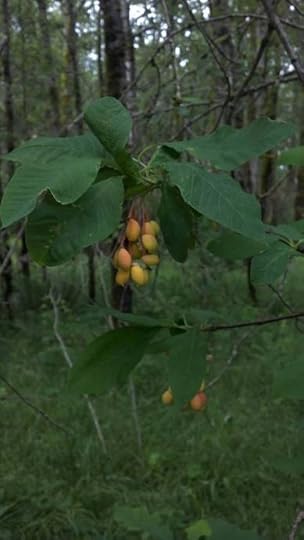
Indian plum, unripe
Indian Plum, Oemleria cerasiformis, is a native shrub that is currently fruiting in the local forests of Portland. The berries are edible and, when ripe, taste like cucumber. They have a very large pit in the center.
The berries shown in the photo here are not yet ripe. The ripe ones are blue-purple in color and look like this.
When it doesn’t have its berries, you can identify Indian Plum by crushing a piece of a leaf and inhaling, because it, too, smells like cucumber.
Indian Plum grows up to 1.5 meters tall and tends to show up on the sides of trails in forests with some partial sunlight at lower elevations. It has alternate leaves. It is found throughout the West Coast in Canada, Washington state, Oregon, and California.
In other news, this blog has a fantastic new resource in the form of the new Search Plants! page, which now has 50 plants listed. It’s an index of plants I’ve covered here on First Ways. Click their names (not the photos) to read posts about them. And if you find it helpful, please tell your friends about it! I’ll be adding more plants all the time.
~~~
Upcoming Classes in Portland:
* Urban Foraging 101 from 2 p.m. to 5 p.m. on Sunday, June 16, in the NE Alberta Arts district. $40. Details here.
* Intro to Herbal Medicine Making, a hands-on class that gets your apothecary started, from 2 p.m. to 5 p.m. on Sunday, June 23, at 1611 SE Bybee. $45 includes all materials and includes a tincture and salve to take home. Details here.
Share this post!
Then learn many more wild plants of spring at my new Search Plants! page.







May 30, 2013
How Oregon Grape Healed Mono
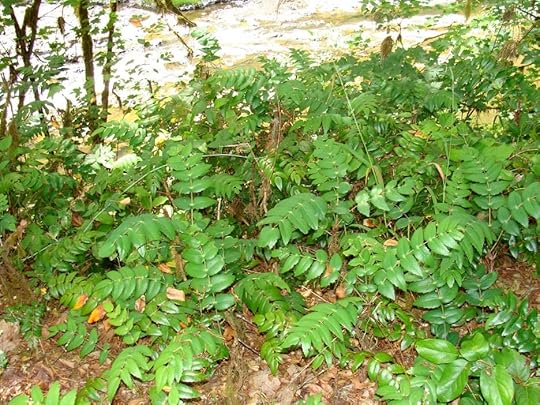
Image by Chris Martin of Arizona State University
When my friend’s nephew was diagnosed with mono recently, his doctor told him that he would likely miss school for a month or longer due to the symptoms, and this was a big deal, because he’s a high school senior, so it meant potentially not graduating. Fortunately, I was more than happy to pass along some of my homemade Oregon grape root tincture to him, and he made a full recovery — in terms of his symptoms — within one week. He’s back to feeling healthy again, and his family is pretty relieved!
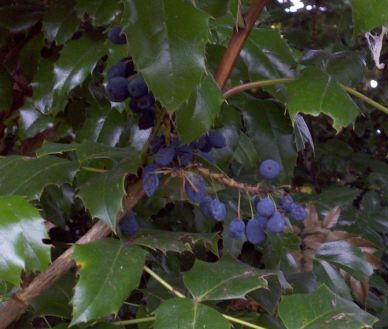
Oregon grape berries / Wikipedia Commons license
I’m not surprised that it worked so very well. Herbal medicine really is effective, and for acute conditions, in my experience, it works quickly. My friend’s nephew is the second person I’ve given Oregon grape root tincture to for mono who made a fast recovery. I’ve also used it successfully for strep throat and cold viruses. The dose he used, and that I usually use, is two medicine droppers, four to five times daily, in tea.
Oregon grape, Mahonia aquifolium, is my favorite medicinal plant. It’s effective for many different ailments, from strep throat to Giardia to mono, and is especially indicated for viral diseases. Oregon grape is native to the Pacific Northwest and it resembles holly, except that holly is a shrub or tree with red berries whereas Oregon grape is an upright bush three to five feet tall or so with matte blue berries.
The roots and berries of the plant have a concentration of an antimicrobial compound called berberine, which stains their insides yellow. Berberine, which is also found in coptis and goldenseal, works synergistically with other chemicals in the herb to bring about healing. And of course, from a metaphysical perspective, the plant spirit is also playing an important role, as is the respectful manner in which the plant was harvested and turned into medicine.
Oregon grape is also an edible plant. The berries are a sour, tart flavor, and the young, soft leaves are citrus-y. The plant’s yellow blossoms are Oregon’s official state flower.
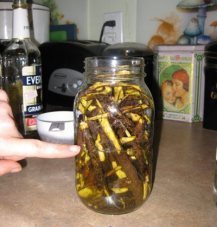 Oregon grape roots can be harvested sustainably because they grow rhizomatically, which means they grow horizontally under the soil like a net, from which numerous plants sprout up. So you can unearth the rhizomes a couple inches beneath the dirt, snip a six-inch (or so) section with garden clippers, and replant the ends. Then you simply rinse and chop the roots, fill a glass jar with them, fill it halfway with 190 proof grain alcohol and the rest of the way with water, screw on the lid, and leave it in the dark at room temperature to extract. It’s ready two to six weeks later, when you have a dark brown-golden liquid inside. (You could do the same with the berries).
Oregon grape roots can be harvested sustainably because they grow rhizomatically, which means they grow horizontally under the soil like a net, from which numerous plants sprout up. So you can unearth the rhizomes a couple inches beneath the dirt, snip a six-inch (or so) section with garden clippers, and replant the ends. Then you simply rinse and chop the roots, fill a glass jar with them, fill it halfway with 190 proof grain alcohol and the rest of the way with water, screw on the lid, and leave it in the dark at room temperature to extract. It’s ready two to six weeks later, when you have a dark brown-golden liquid inside. (You could do the same with the berries).
In a survival situation without a tincture handy, one could boil the roots and use the heat to extract the medicinal compounds into a tea.
Edited to add: In addition to the Oregon grape root tincture, I also gave my friend’s nephew a 2 oz bottle of some cleavers tincture to help him cleanse and support his lymphatic system, which mono stresses. (As it happens, mono also impacts the liver, and Oregon grape happens to be a good herb for cleansing the liver in addition to its anti-viral properties.)
What I’ve just described, and what I generally write about here, would be called “folk herbalism,” in the sense that it’s distinguished from the more sophisticated systems of energetic herbalism developed over thousands of years in China and India, and, in times past, also in Greece and the Middle East. Those systems are especially useful for treating chronic ailments.
I’ve been wanting to learn more about these traditions, and study herbal medicine more formally in general, so I recently enrolled in a distance herbal study course designed by the very respected teacher Michael Tierra, who is based in Santa Cruz, California, founded the American Herbalists Guild, and has formally studied and authored books on Traditional Chinese Medicine as well as Ayurveda (traditional Indian herbal medicine). He also trained with Native American healers and folk herbalists. His school is called the East West School of Planetary Herbology. The term “planetary” is meant to denote respect for all traditions, including folk and indigenous healing. I find this philosophy very refreshing.
I’m only a couple hundred pages into this course, but so far, I’m learning tons, and would recommend it to anyone who is looking to enhance their knowledge at their own pace. You can take up to three years to complete the course, and it is comprehensive, with various directions, so that you can choose to stop after the first twelve lessons, which are supposed to give you enough learning to be a home herbalist, or going into the full thirty-six, with additional courses on pathology and disease and anatomy and even an option to apprentice for hundreds of hours to become a certified clinical herbalist. Another bonus is that it’s about half as expensive as an in-person school.
***
Upcoming Classes in Portland, Oregon:
* Urban Foraging 101 from 2 p.m. to 5 p.m. on Sunday, June 16, in the NE Alberta Arts district. $40. Details here.
* Stinging nettle plant-spirit meditation from 7 p.m. to 9 p.m. on Thursday June 6. $20 to $40 sliding scale. Details here.
* Intro to Herbal Medicine Making, a hands-on class that gets your apothecary started, from 2 p.m. to 5 p.m. on Sunday, June 23, at 1611 SE Bybee. $45 includes all materials and includes a tincture and salve to take home. Details here.
***
Share this post!
Then learn many more wild plants of spring at my new Search Plants! page.







May 25, 2013
An Urban Forager at the March Against Monsanto
—
 My name is Becky Lerner and I wrote the book
Dandelion Hunter
, and I’m also a nature educator here in Portland, and a blogger at the website FirstWays.com. I’m here standing with you today because I’m an urban forager. I pick wild plants in the urban areas in Portland and I eat them and make herbal medicines with them. And I teach other people how to do this, too. I have a vested interest in a clean, toxin-free city. I’m very concerned about exposing myself and others to pesticides. I’m also really interested in giving our community access to this free food and medicine. My passion is letting people know that wild plants are useful to us, and that nature’s wild abundance is a gift, something to embrace, not something we need to dominate or kill – especially with toxic chemicals.
My name is Becky Lerner and I wrote the book
Dandelion Hunter
, and I’m also a nature educator here in Portland, and a blogger at the website FirstWays.com. I’m here standing with you today because I’m an urban forager. I pick wild plants in the urban areas in Portland and I eat them and make herbal medicines with them. And I teach other people how to do this, too. I have a vested interest in a clean, toxin-free city. I’m very concerned about exposing myself and others to pesticides. I’m also really interested in giving our community access to this free food and medicine. My passion is letting people know that wild plants are useful to us, and that nature’s wild abundance is a gift, something to embrace, not something we need to dominate or kill – especially with toxic chemicals.We talk about farmers dousing our land in Roundup, and the dangers that causes to our health and the Earth. It’s why we buy organic. But what a lot of people don’t know is that this same chemical cocktail is being sprayed in lawns and parks all around us. Homeowners use 10 times more Roundup per acre than farmers do. Not only are our neighbors spraying it all over the place, but so are we – through our tax dollars, which the city spends on Roundup to spray in the parks. It’s in this park we’re standing in right now, in the rings around the trees, where the deadzones are. It doesn’t have to be this way.
Anyone who’s enjoyed dandelion coffee or blackberry syrup or garlic mustard pesto, or who’s drank red clover flower or mullein leaf tea, or who’s made a salve with St Johns Wort, understands how useful weeds can be for us.
The city of Portland and Metro kill very useful edible and medicinal wild plants using Monsanto’s flagship product, Roundup. Our tax dollars go directly into Monsanto’s pockets. If you talk to people who work for Metro, or for the Portland parks, they’ll tell you that they trust Monsanto’s claims that Roundup is safe. But I don’t trust Monsanto. In two instances, the EPA caught labs hired by Monsanto falsifying data on Roundup to make it sound safer than it is. The European Union lists its active ingredient, glyphosate, as “dangerous for the environment” and “toxic to aquatic organisms.” Studies link also it to birth defects in animals exposed to it and to cancer. The EPA is actually now re-evaluating Roundup’s active ingredient and is considering banning it in 2015.
We’re Portland. We’re supposed to be leading the nation in being green. All around the country, cities are banning the use of pesticides, especially Roundup, in their parks. Ninety percent of Chicago’s parks are chemical-free. The parks in Boulder, Colorado, banned Roundup. Why not Portland?
Thank you.
***
To browse some of the useful wild plants available this season, visit my new Search Plants! page.
***
Upcoming Classes:
– Urban Foraging 101 tomorrow (Sunday May 26), 2 pm to 5 pm, in NE Portland. $40. Info here.
– Stinging Nettle guided plant-spirit meditation, 7 pm to 9 pm Thursday June 6, in NE Portland. $20 to $40 sliding scale. Info here.
– Herbal Medicine 101 from 2 p.m. to 5 p.m. on Sunday June 23 in SE Portland. $45, including medicines and materials. Info here.










